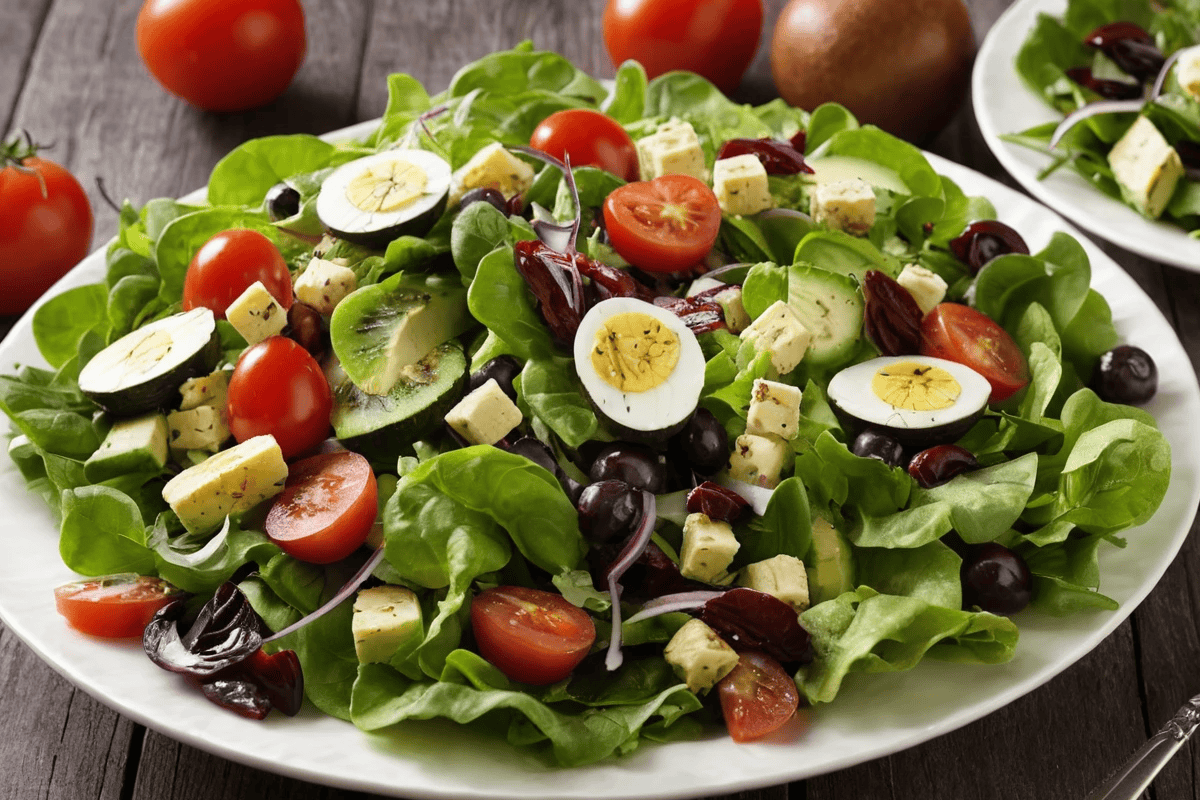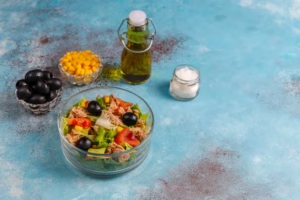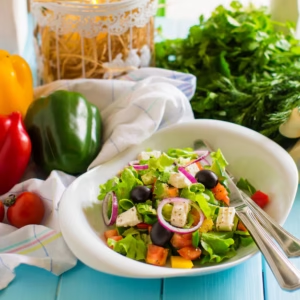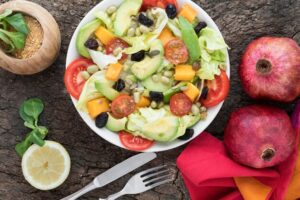Health salads are not just a side dish—they’re an essential part of a balanced, nutritious diet. Whether you’re looking to eat cleaner, lose weight, or simply enjoy a variety of vibrant, fresh ingredients, health salads are the perfect option. Packed with antioxidants, fiber, and essential nutrients, they make for a satisfying meal that boosts energy and well-being.
Health salads are not just a side dish—they’re an essential part of a balanced, nutritious diet. Whether you’re looking to eat cleaner, lose weight, or simply enjoy a variety of vibrant, fresh ingredients, health salads are the perfect option. Packed with antioxidants, fiber, and essential nutrients, they make for a satisfying meal that boosts energy and well-being.
In this guide, we’ll explore everything you need to know about creating the perfect health salad—from the essential ingredients to the best healthy dressings, and even some of our favorite recipes. If you’re looking for inspiration, check out these Healthy Salad Recipes from EatingWell and Allrecipes Healthy Salad Recipes for a variety of options. Let’s dive in!
Nutritional Benefits of Health Salads
Incorporating a health salad into your diet offers numerous benefits. Here’s a breakdown of why health salads are an excellent choice for anyone looking to improve their nutrition:
- High in Fiber: Most health salads feature leafy greens and other vegetables that are rich in fiber, helping to regulate digestion and promote satiety. Fiber is also key for maintaining blood sugar levels and lowering cholesterol.
- Packed with Antioxidants: With ingredients like spinach, kale, and tomatoes, these salads are loaded with antioxidants, which help protect your cells from oxidative stress and inflammation. Regularly consuming antioxidant-rich foods has been linked to a reduced risk of chronic diseases, including heart disease and cancer.
- Low-Calorie: Health salads are naturally low in calories, making them an ideal choice for anyone looking to manage their weight without compromising on flavor or nutrition. These salads are packed with low-calorie vegetables, making them a great option for a light, satisfying meal.
- Supports Heart Health: Many health salads incorporate heart-healthy fats like avocados, nuts, and seeds. These fats, particularly omega-3 fatty acids, play a crucial role in reducing inflammation and improving overall heart function.
For more ideas, check out EatingWell’s guide to healthy salad recipes, which includes various salads designed to improve overall health.
Key Components of a Health Salad
A health salad is only as good as its ingredients. When choosing components, aim for a balance of textures, colors, and nutrients. Here’s a guide to the essential elements of any health salad:
1. Leafy Greens
Leafy greens should be the foundation of any health salad. They provide a wealth of vitamins, minerals, and fiber that promote digestion and overall health. Some of the best leafy greens to include are:
- Spinach: High in iron, vitamins A, C, and K, and folate. Great for bone health, immune support, and skin health.
- Kale: A superfood packed with antioxidants and fiber. Kale is also high in calcium, which supports bone health.
- Arugula: A slightly peppery green that adds flavor and is rich in calcium, potassium, and folate.
- Mixed Greens: A blend of various leafy greens, often including arugula, spinach, and romaine lettuce. This variety ensures a good range of vitamins and minerals.
2. Colorful Vegetables
Adding a rainbow of vegetables to your salad not only makes it visually appealing but also enhances the nutritional value. Vegetables are rich in vitamins, minerals, and antioxidants. Consider adding:
- Bell Peppers: A great source of vitamin C, which boosts the immune system and promotes healthy skin.
- Carrots: High in beta-carotene, which the body converts to vitamin A. This is essential for eye health and immune function.
- Cucumbers: Low in calories and rich in water content, cucumbers are perfect for hydration and adding crunch.
- Beets: High in fiber, vitamins, and antioxidants, beets can help improve blood flow and lower blood pressure.
- Tomatoes: Rich in lycopene, a powerful antioxidant linked to a lower risk of heart disease and certain types of cancer.
3. Lean Proteins
To make your health salad more filling, adding lean protein is essential. Protein helps in muscle repair, boosts metabolism, and keeps you full longer. Some great lean protein options include:
- Grilled Chicken: Low in fat and a great source of protein, essential for muscle growth and repair.
- Tofu: A versatile, plant-based protein packed with essential amino acids and low in fat.
- Chickpeas: A plant-based protein rich in fiber, iron, and folate. Chickpeas can help regulate blood sugar and support digestive health.
- Hard-Boiled Eggs: A great protein source that also provides vitamin D and B vitamins, supporting energy levels and immune function.
4. Healthy Fats
Healthy fats are crucial for absorbing fat-soluble vitamins (like vitamins A, D, E, and K) and maintaining brain health. Here are some healthy fats to add to your salad:
- Avocados: Full of monounsaturated fats, which are heart-healthy and can help reduce bad cholesterol.
- Nuts and Seeds: Almonds, walnuts, chia seeds, and flaxseeds add texture and provide healthy fats, fiber, and protein.
- Olives: Rich in monounsaturated fats, which have anti-inflammatory properties and are beneficial for heart health.
5. Whole Grains
Including whole grains in your salad provides a source of complex carbohydrates, which are digested more slowly, providing sustained energy. Some great whole grains for salads include:
- Quinoa: A gluten-free grain that is a complete protein, containing all nine essential amino acids.
- Farro: An ancient grain high in fiber, iron, and B vitamins. It adds a chewy texture and nutty flavor to your salad.
- Brown Rice: Full of fiber, brown rice helps keep you full and supports digestion.
- Barley: A rich source of soluble fiber, which helps control blood sugar and lower cholesterol.
Health Salad Dressings
While a salad’s ingredients are important, the dressing plays a key role in flavor and texture. It’s important to choose dressings that complement the health benefits of the salad, rather than mask them with excess sugar or fat. Here are a few tips for healthy salad dressings:
1. Go for Homemade
Homemade vinaigrettes made with olive oil, apple cider vinegar, mustard, and a touch of honey are healthier than store-bought dressings packed with preservatives and sugar. Plus, they are easy to make and customizable based on your tastes.
2. Experiment with Creamy Alternatives
If you prefer creamy dressings, try options made with Greek yogurt, avocado, or cashew cream. These ingredients are healthier alternatives to traditional creamy dressings, which are often high in calories and fat.
- Greek Yogurt Ranch: Mix Greek yogurt with fresh herbs like dill and parsley for a creamy, lower-calorie alternative to traditional ranch.
- Avocado Dressing: Blend avocado with lime juice, olive oil, and garlic for a creamy, flavorful dressing that’s packed with healthy fats.
Popular Health Salad Recipes
Looking for some quick and delicious health salad ideas? Here are a few tried-and-true recipes that are not only tasty but also full of nutrients:
- Spinach Salad with Quinoa, Chicken & Fresh Berries: This protein-packed salad includes quinoa, lean chicken breast, fresh berries, and spinach for a refreshing, filling meal. The sweetness of the berries pairs wonderfully with the savory chicken and quinoa.
- Eat-the-Rainbow Vegetable Salad: Featuring a mix of colorful vegetables like red cabbage, carrots, and bell peppers, this salad offers a variety of vitamins and minerals that will support your immune system. The bright, crunchy vegetables provide a satisfying texture and burst of flavor.
- High-Protein Tuna & Chickpea Salad Sandwich: This protein-rich salad combines tuna, chickpeas, and vegetables, making it a hearty, nutritious meal. The addition of chickpeas makes the salad extra filling, while the tuna provides lean protein.
- Roasted Cabbage Salad with Citrus Vinaigrette: Roasting the cabbage gives it a delicious smoky flavor, which pairs wonderfully with a tangy citrus dressing. This salad is a great way to incorporate a less commonly used vegetable into your meals.
- Roasted Squash & Lentil Kale Salad: A great vegetarian option, this salad incorporates roasted squash and lentils for a hearty, filling dish that’s high in fiber and protein. The earthy flavors of the squash and lentils are complemented by the bright acidity of a lemon vinaigrette.
Meal Planning with Health Salads
Health salads are incredibly versatile, making them perfect for meal planning. You can easily prepare them in advance and store them for several days. Here’s how to make meal planning with health salads work for you:
1. Batch Prep
Prepare salad ingredients like vegetables, grains, and proteins ahead of time. Store them in separate containers and assemble your salad when you’re ready to eat. This saves time during the week and ensures you always have a healthy meal on hand.
2. Use Mason Jars for Storage
Layering ingredients in mason jars helps keep your salad fresh longer. Start with the dressing at the bottom, followed by hard vegetables, proteins, and leafy greens at the top. This method ensures that your salad won’t get soggy before you’re ready to eat it.
3. Balance Macronutrients
Ensure your salad is balanced by including a variety of protein, healthy fats, and carbs to keep you full and satisfied. This can also help prevent your salad from feeling like a side dish and turn it into a complete, nourishing meal.
Common Mistakes to Avoid When Preparing Healthy Salads
While health salads are a great choice, it’s important to avoid certain mistakes that can take away from their nutritional benefits:
- Overdressing: Too much dressing can turn your salad into a calorie-heavy meal. Opt for a light drizzle or keep the dressing on the side.
- Pre-Packaged Ingredients: Some pre-packaged salad kits come with added sugars, preservatives, and artificial flavors. Choose fresh, whole ingredients whenever possible.
- Imbalance of Nutrients: Make sure your salad includes a variety of vegetables, protein, healthy fats, and whole grains for a well-rounded, nutritious meal.
Frequently Asked Questions (FAQs)
How can I make my health salad more filling?
To make your salad more filling, include lean proteins like chicken or tofu, healthy fats like avocado or nuts, and whole grains like quinoa or brown rice.
Can I prepare health salads in advance?
Yes, you can prepare health salads in advance by prepping the ingredients and storing them separately. Just assemble the salad when you’re ready to eat.
What are some low-calorie dressing options?
For low-calorie options, try using a simple vinaigrette made from olive oil, balsamic vinegar, and a small amount of mustard.
How do I prevent my salad from getting soggy?
To prevent sogginess, store the dressing separately and add it just before serving. Also, avoid adding watery ingredients like cucumbers until you’re ready to eat.
Can health salads aid in weight loss?
Yes, health salads are a great option for weight loss due to their low calorie content and high fiber, which helps keep you full longer.
For more tips on healthy eating and meal preparation, check out our Ultimate Guide to Vegetarian Raw Food Recipes & Health Benefits, which includes meal ideas and tips that complement health salad recipes.
By following these tips, you can create a wide variety of health salads that are both delicious and nourishing. Whether you prefer green salads or hearty, grain-based bowls, there’s an option for everyone.




